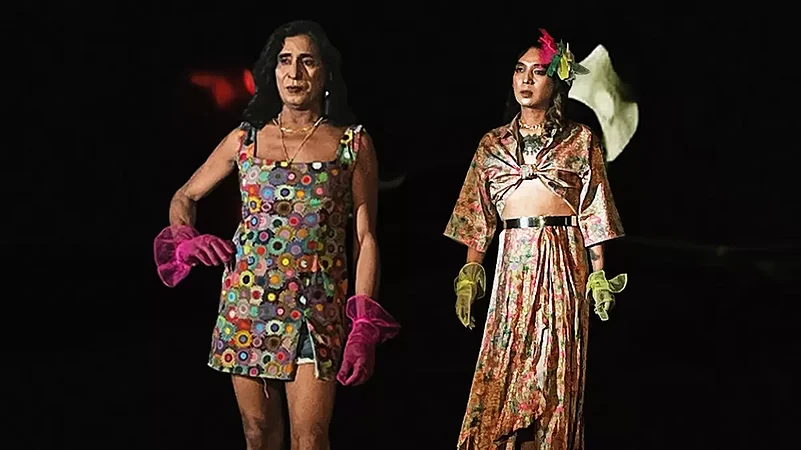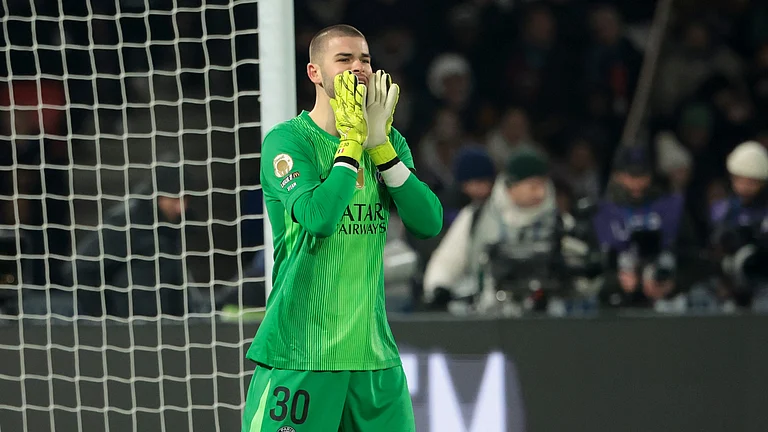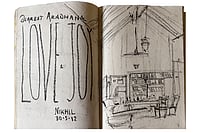She walked slowly as if she was making up for all the time she had lost in hoping and waiting. Perhaps despairing too. But that evening, 69-year-old Chandani, a trans-female model, was the first one to face the audience. She walked slowly as if she was soaking it all in. The camera flashes, the applause, the whispers. She walked as if she had always known this space. To be gorgeous, you must be seen first. After all, she was shattering the notions of beauty.
Pink gloves, short dress with flowers on it and a slit, high heels and those piercing eyes. Chandani was sheer gorgeousness.
Hands over their bodies, moving gently and then with ferocity, the eight trans models looked with eyes that held in them a gaze that flashed many emotions. Defiance, betrayal and a lot of sadness. A little flash of hope mixed with some triumph too. Finally, they had done it. Managed to own the runway. Friends and allies came to cheer them. It had been raining in the capital that Sunday evening.
They wore the rainbow colours, a clichéd concept, but one that kind of makes a case for identity, net gloves like Miss Havisham in Charles Dickens’ Great Expectations would wear as she dealt with betrayal, which then made her into a transgressive character. They defied all gender, body type and age restrictions on the ramp that night that had a black carpet and none of that grandeur that projects a fantasia, the usual tropes that designers and fashion houses rely on, were storyboards. They were the transgressors, the outcastes, the ones who wrestle with aspiration and reality in a country where designers often resort to lip service about inclusion and diversity but end up being conservative about fashion with no compelling narratives. They are always talking about brides, a free soul, etc. Outdated stuff. The thing is they never took a risk.
This wasn’t tokenism at all.
They had named it “come as you are” after the famous Nirvana song written by late Kurt Cobain. The song is about society’s expectations that can make people crazy. The show was part of the Mental Health Awareness Week at the India Habitat Centre in the national capital, the first of its kind where designer Priyal Thakkar, who is the creative director and founder of Rainbow Monkey that was set up in 2019 with a mission to bring “equality in fashion”, agreed to dress up the models in outfits that had geometrical shapes and floral motifs in a range of colours that contrasted with some of that sadness the models had spoken about not being ever given a chance. Rudrani Chhetri, the founder of a transgender modelling agency called Bold Transgender Modelling Agency (BOLDT), says that for seven years she had tried to find designers and shows and platforms that would give them a chance, some visibility. She had been emboldened by the rhetoric that fashion in India was indeed changing and androgyny had already made its presence on the runway alongside the brides.
“No designer ever entertained us,” she says. “It was heartbreaking for our models.”
Chandani had been around when Rudrani opened the agency and she said she wanted to be one of her girls.
“She is so brave,” she says.

Chandani has seen a time where there were no conversations around trans community. She never found a job except what was assigned to them by the society. To ask for alms. But Chandani wanted so many things. She wanted to be an actor, a model, a somebody.
On Sunday, she became one of those.
“That’s realness,” Rudrani says.
The show was more about an assertion in the world of fashion with its army of press people, who place stories on fashion with a twist in the media. But outlandish is what it is. It is a story worth telling. About those who dared to walk and do a course correction. It did not have a front row setting with fashion editors flexing their muscles. It did not have the big designers. There were no celebrities. All they had was audacity of hope strengthened by the sheer betrayal that has always been part of their lives.
“That makes us stronger than you’d imagine,” says Chhetri, an activist and actor. At 45, she is battle-hardened.
The Lakmé Fashion Week X FDCI is ongoing in another city. Maybe next time we might make it there, she says.
In a fascinator hat that had ribbons in green and purple and yellow and fuschia cascading on one side of her face, Chhetri walked with abandon and looked in the eyes of the audience. An unapologetic gaze. In this world, all expressions are deeply personal. The binaries of gender and constrictive and trans fashion remain a challenge for designers. Representation even more so. Things have been changing, though. In 2017, designer Marc Jacobs had an 18-year-old trans model walk down the runway in a turban inspired by one of the most irreverent fashion editors called Diana Vreeland and in an orange pantsuit that echoed Elvis Presley’s style. Casil McArthur, the model, said it was all about acceptance and it could go a long way in changing a lot of things for the trans community and culture at large. But in India, the non-inclusion is pervasive. Even with the film industry, the trans characters are mostly played by cisgender actors. For instance, Sushmita Sen will now play trans-female Gauri Sawant in a biopic called Taali. In 2018, designer Sohaya Misra presented a runway show called “Bye, Felicia” which was to signify the ultimate dismissal with a sassy movement of the hand. Misra, whose brand Chola made drag queens walk the ramp at the Lakmé Fashion Week, had actor Prateik Babbar in ‘drag’, who closed the show with make-up artist Jason Arland dressed as his bride in a veil and a peach dress. The nuance of drag was lost somewhere. That has always been the case. The casting has always been an issue.
Perhaps, that’s why Rudrani thought of doing her own show. Perhaps, to make that invisibility go away. They got makeup brand Colorbar Cosmetics to do their makeup and that was good, she says.
At one point, Rudrani stood with her hands outstretched. With her, there is always a performative element. A communication through gestures, eyes. The body became her projection screen.
The show intended to claim a space that has been grappling with diversity and inclusion issues in terms of body and identity representations, which have often been called out. In a post-pandemic fashion scenario, designers like Gaurav Gupta came out with a collection called “Name is Love” in September 2020 for the digital edition of the fashion week featuring a trans-male and a trans-female alongside gay and lesbian couples. The trans-female was Nepalese model Anjali Lama, who had first walked the runway in 2017 at Lakmé Fashion Week after having faced many rejections earlier. At 32, she became the first trans model to walk the ramp. Lama became the poster child of inclusivity in gender landscape in fashion. Rudrani’s models never found any work. They started the agency in 2015.
“She had this foreigner tag and she was from elsewhere,” says Rudrani. “We never got lucky.”
Whether this small attempt at pitching real inclusivity will change the grand old setup in fashion in India that thrives on romanticised versions of a bride, it remains to be seen.
But that night, the eight models formed a circle and held red roses in their gloved hands, which they later passed around to each other and eventually, they placed it on the black carpeted runway.
“We offered them to those who see us but don’t acknowledge us. We are against this imposed invisibility,” Rudrani says.
That’s how it ended. With an offering of love, an antidote to all otherness.
(This appeared in the print edition as "“Don’t you see me”")

























